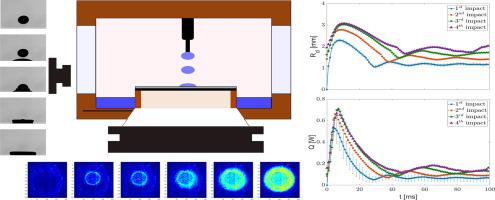当前位置:
X-MOL 学术
›
Exp. Therm. Fluid Sci.
›
论文详情
Our official English website, www.x-mol.net, welcomes your
feedback! (Note: you will need to create a separate account there.)
Experimental investigation of hydrodynamics and heat transport during vertical coalescence of multiple successive drops impacting a hot wall under saturated vapor atmosphere
Experimental Thermal and Fluid Science ( IF 2.8 ) Pub Date : 2020-10-01 , DOI: 10.1016/j.expthermflusci.2020.110145 Alireza Gholijani , Tatiana Gambaryan-Roisman , Peter Stephan
Experimental Thermal and Fluid Science ( IF 2.8 ) Pub Date : 2020-10-01 , DOI: 10.1016/j.expthermflusci.2020.110145 Alireza Gholijani , Tatiana Gambaryan-Roisman , Peter Stephan

|
Abstract In this study, hydrodynamics and heat transport during the vertical coalescence of multiple successive drops impacting a hot wall are analyzed experimentally. This study addresses the influence of wall superheat and the frequency of drop generation on the hydrodynamics and heat transport. The experiments are conducted under a pure vapor atmosphere with the refrigerant FC-72 at a saturation temperature of 54.5 ° C, corresponding to a system pressure of 0.94 bar. The drops are generated with a constant diameter of 1.14 mm and a constant impact velocity of 0.54 m s−1. An infrared camera with a high spatial and temporal resolution is used to capture the temperature field on the surface of the heater. The local heat flux distribution is derived from the temperature field by solving the transient three-dimensional heat conduction equation within the substrate. The total heat flow is evaluated by integrating the local heat flux over the footprint of the drop. The impact parameters (drop size and impact velocity) are evaluated through post-processing of the black/white images captured using a high-speed camera. The maximum spreading radius and maximum heat flow observed after the impact of each successive drop are higher than those observed after the impact of the previous drop. For instance, in the case of a wall superheat of 12.4 K and an impact frequency of 10 Hz, the maximum spreading radius and maximum heat flow observed after the impact of the fourth drop increased by approximately 35% compared with those observed after the impact of the first drop on a dry wall. The distribution of wall heat flux during the spreading phase of the second impacting drop is characterized by the appearance of two thin ring-shaped zones of high heat flux. The time evolutions of the drop shape and heat flow depend on the wall superheat and are independent of the frequency of drop generation within the studied range of parameters.
中文翻译:

饱和蒸汽气氛下多个连续液滴撞击热壁的垂直聚结过程中的流体动力学和热传输的实验研究
摘要 在这项研究中,通过实验分析了多个连续液滴撞击热壁的垂直合并过程中的流体动力学和热传输。这项研究解决了壁面过热和水滴产生频率对流体动力学和热传输的影响。实验在纯蒸汽气氛下进行,制冷剂为 FC-72,饱和温度为 54.5°C,对应的系统压力为 0.94 bar。液滴以 1.14 毫米的恒定直径和 0.54 ms-1 的恒定冲击速度产生。使用具有高空间和时间分辨率的红外相机来捕捉加热器表面的温度场。通过求解衬底内的瞬态三维热传导方程,从温度场导出局部热通量分布。总热流通过对液滴足迹上的局部热通量进行积分来评估。撞击参数(液滴大小和撞击速度)通过对使用高速相机拍摄的黑白图像进行后处理来评估。每次连续跌落撞击后观察到的最大扩散半径和最大热流均高于前一次跌落撞击后观察到的。例如,在壁面过热度为 12.4 K 和冲击频率为 10 Hz 的情况下,与第一次撞击干墙后观察到的相比,第四次撞击后观察到的最大扩散半径和最大热流增加了约 35%。在第二次撞击的扩散阶段,壁面热通量的分布特点是出现了两个高热通量的薄环形区域。液滴形状和热流的时间演变取决于壁面过热度,并且与研究的参数范围内液滴产生的频率无关。
更新日期:2020-10-01
中文翻译:

饱和蒸汽气氛下多个连续液滴撞击热壁的垂直聚结过程中的流体动力学和热传输的实验研究
摘要 在这项研究中,通过实验分析了多个连续液滴撞击热壁的垂直合并过程中的流体动力学和热传输。这项研究解决了壁面过热和水滴产生频率对流体动力学和热传输的影响。实验在纯蒸汽气氛下进行,制冷剂为 FC-72,饱和温度为 54.5°C,对应的系统压力为 0.94 bar。液滴以 1.14 毫米的恒定直径和 0.54 ms-1 的恒定冲击速度产生。使用具有高空间和时间分辨率的红外相机来捕捉加热器表面的温度场。通过求解衬底内的瞬态三维热传导方程,从温度场导出局部热通量分布。总热流通过对液滴足迹上的局部热通量进行积分来评估。撞击参数(液滴大小和撞击速度)通过对使用高速相机拍摄的黑白图像进行后处理来评估。每次连续跌落撞击后观察到的最大扩散半径和最大热流均高于前一次跌落撞击后观察到的。例如,在壁面过热度为 12.4 K 和冲击频率为 10 Hz 的情况下,与第一次撞击干墙后观察到的相比,第四次撞击后观察到的最大扩散半径和最大热流增加了约 35%。在第二次撞击的扩散阶段,壁面热通量的分布特点是出现了两个高热通量的薄环形区域。液滴形状和热流的时间演变取决于壁面过热度,并且与研究的参数范围内液滴产生的频率无关。











































 京公网安备 11010802027423号
京公网安备 11010802027423号